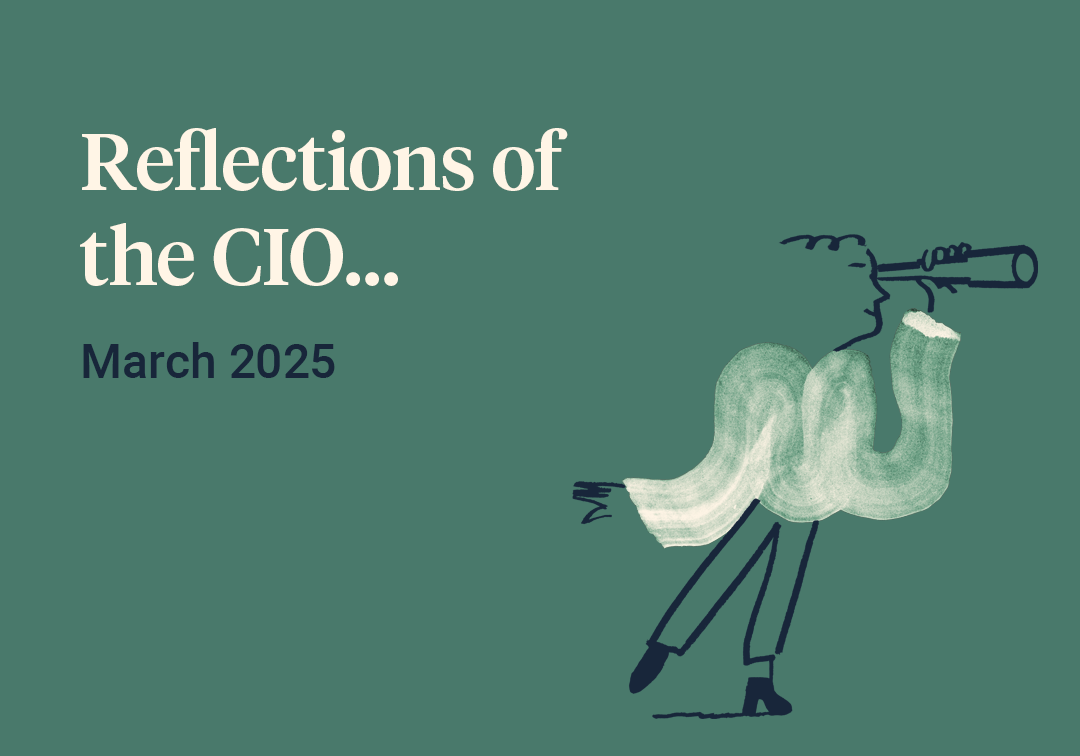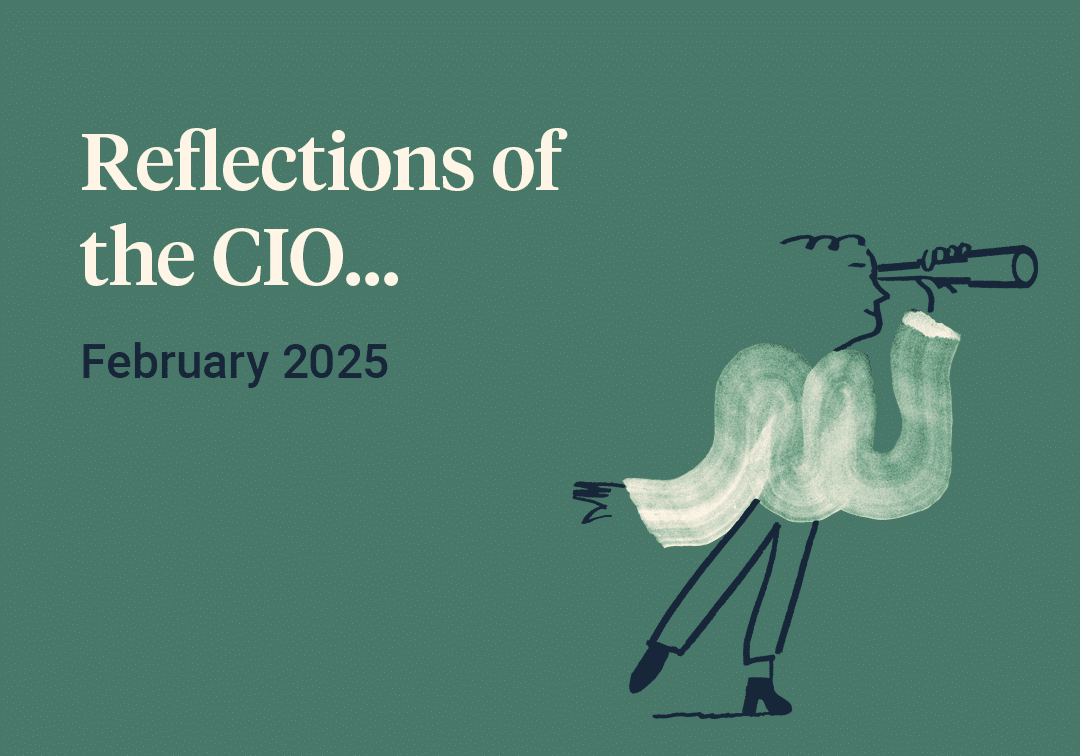The New Year has begun well, with markets displaying a high degree of ‘sang froid’ in the face of fast changing and dramatic news flow. Sentiment ebbed and flowed, ending on what we would describe as a fragile high, but a high, nonetheless.
As could have been expected, January ended up being dominated by US politics, particularly in the latter part of the month after the inauguration of President Donald Trump. Prior to this, equity markets were trading very well, powered by ongoing strength in the US economy and a series of inflation readings that turned out to be relatively benign compared to estimates. The scene was now set for investors to digest and absorb the detail of how the new administration was going to direct its energies.
Although many headlines were generated by a flurry of executive orders on day one, market attention was firmly fixed upon the early imposition of tariffs on Mexico, Canada and China, three countries which supply over $1.3 trillion of goods to the USA.[1] Consensus opinion had generally taken the attitude that these policies would end up being more ‘bark than bite’ – a series of negotiating ploys which would ultimately end up being watered down in return for concessions elsewhere. Such views were put to the test right at the end of January, with 25% tariffs imposed upon Canadian and Mexican goods and 10% on Chinese ones.[2] It was now abundantly clear to all that the administration was prepared to take some pain in pursuit of their objectives and did not share the markets view that tariffs were a bad idea.
Concurrent with all this news, another event happened unexpectedly, throwing a curve ball into consensus thinking in the technology sector. The potential of artificial intelligence (AI) tools to significantly enhance economic productivity has been a crucial driver of stock market returns over the last two years, with enormous amounts of value created in the leading US technology companies (the so called Magnificent 7) and their associated supply chains. In late January, coincidentally (?) timed to align with the arrival of a new President, a Chinese AI company called DeepSeek announced that it had not only produced a generative AI product as good as anything the US had made but had done so at a fraction of the cost.[3] The methodology and source code behind this breakthrough were also made available for all to see and use. At one stroke, the idea that the only way to access useful AI products had to be through US tech companies, or by sinking vast sums into R&D, was shattered. Nvidia, the largest supplier of expensive AI hardware, previously thought to be indispensable, lost nearly $700bn of value in one day as the news reverberated across the globe.[4]
Do you need help managing your investments?
Our team can recommend an investment strategy to meet your financial objectives and give you peace of mind that your investments are in good hands. Get in touch to discuss how we can help you.

Impressively, stock markets took this news in their stride, with a targeted sharp selloff in the most directly affected companies i.e. those riding the AI capex boom, as opposed to an indiscriminate panic. Technology stocks which conceivably benefitted from the DeepSeek news – as it would ultimately act to accelerate the development of useful products and expand the overall market – were left alone or even marked up in price. It took a few days for things to settle, but in the end settle they did, leaving us to think that this particular shock may turn out to be a healthy one, knocking some froth out of the AI bubble without collapsing everything at once.
As we write in early February, we now know that Canada and Mexico have been given a temporary reprieve for a month, but China has not. The resulting mix of policy uncertainty has now begun to weigh more heavily on market sentiment, especially as tariff policy towards the rest of the world i.e. the UK and EU has yet to be announced. Certain assets, such as gold, which thrive in uncertain environments, performed strongly throughout January, leaving your investment committee with something of a dilemma to reconcile as we think about the investment environment form here. On the surface, there is nothing new to worry about and portfolios and markets have generally had a good start to the year, however we also sense a growing sense of unease below the surface, evidenced by the strong performance of gold and the high volatility in foreign exchange markets. Government bond markets are also starting to reflect the risk of tariff wars on economic growth, especially since the process with China is so early in the game, and it’s hard to see any obvious ‘off ramps’ for de-escalation at this stage.
In equity markets, we think there is a risk that the current relaxed approach to tariff impacts could be reassessed, depending upon how aggressive the new administration proves to be. For example, J.P. Morgan has estimated that if proposed tariffs on Mexico and Canada were imposed for a prolonged period, they could reduce U.S. economic growth by 0.5% to 1% and increase inflation by the same amount, potentially slowing corporate profit growth significantly.[5] Having to price in this risk whilst simultaneously maintaining enthusiasm for an AI theme which is being disrupted by new innovation, is unlikely to be a smooth or easy thing to do.
We will be mulling the implications of the points raised above in our asset allocation meeting this month and without prejudging any outcomes, it is quite likely that we will be pushing portfolio diversification even wider to balance out risks with rewards. There is good valuation led opportunities in equity markets outside the US as well as multiple ‘volatility loving’ strategies in the alternatives arena, which give us a route to maintaining enough portfolio risk to make a decent return, whilst not being too dependent upon any one particular outcome. In a mercurial investment climate, with so many variables resistant to traditional analysis, keeping portfolio risk in place but in a highly diversified manner should hopefully equip us well to deal with the twists and turns the rest of the year will inevitably bring.
With thanks for your continued support,
The Saltus Investment Team, January 2025
Do you need help managing your investments?
Our team can recommend an investment strategy to meet your financial objectives and give you peace of mind that your investments are in good hands. Get in touch to discuss how we can help you.

Article sources
Editorial policy
All authors have considerable industry expertise and specific knowledge on any given topic. All pieces are reviewed by an additional qualified financial specialist to ensure objectivity and accuracy to the best of our ability. All reviewer’s qualifications are from leading industry bodies. Where possible we use primary sources to support our work. These can include white papers, government sources and data, original reports and interviews or articles from other industry experts. We also reference research from other reputable financial planning and investment management firms where appropriate.
The views expressed in this article are those of the Saltus Asset Management team. These typically relate to the core Saltus portfolios. We aim to implement our views across all Saltus strategies, but we must work within each portfolio’s specific objectives and restrictions. This means our views can be implemented more comprehensively in some mandates than others. If your funds are not within a Saltus portfolio and you would like more information, please get in touch with your adviser. Saltus Asset Management is a trading name of Saltus Partners LLP which is authorised and regulated by the Financial Conduct Authority. Information is correct to the best of our understanding as at the date of publication. Nothing within this content is intended as, or can be relied upon, as financial advice. Capital is at risk. You may get back less than you invested. Tax rules may change and the value of tax reliefs depends on your individual circumstances.
Related blog posts
About Saltus?
Find out more about our award-winning wealth management services…
Winner
Best Wealth Manager
Winner
Investment Performance: Cautious Portfolios
Winner
Top 100 Fund Selectors 2024
Winner
Best Places to Work 2024
£8bn+
assets under advice
20
years working with clients
350+
employees
97%
client retention rate


